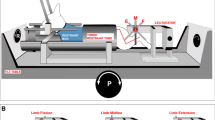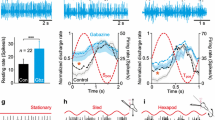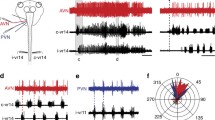Summary
1. Experiments were carried out on an in vitro preparation of the lamprey brainstem isolated together with intact labyrinths. Responses of reticulospinal neurons from different brainstem reticular nuclei (mesencephalic, MRN; anterior rhombencephalic, ARRN; middle rhombencephalic, MRRN; and posterior rhombencephalic, PRRN) to rotation of the preparation (0°–360°) either in the sagittal plane (pitch tilt, or nose up-down movement) or in the transverse plane (roll tilt, or left-right inclination) were recorded. 2. Responses to roll tilt were qualitatively similar in all nuclei: contralateral side down tilt (in relation to the location of the neuron in the brain) caused an activation of reticulospinal neurons. The angular thresholds for activation differed, however, between nuclei as well as the angle at which the maximal activity occurred. The maximal response for MRN was at 45°, for MRRN and PRRN at 90°, for ARRN at 180°. Thus, the zones of spatial sensitivity differed in different nuclei, and they covered the whole range of possible inclinations in the transverse plane. 3. Responses to pitch tilt were not uniform in the different nuclei. MRN neurons responded preferentially in the range of 45°–90° nose-up inclinations, but a proportion of the cells responded in the range of 45°–90° nose-down inclinations. The ARRN neurons had their maximal response when the brain was turned to a dorsal side-down position (180°). In the MRRN, three subgroups of neurons could be distinguished, the first responding at around 90° nose-down, the second responding at around 90° nose-up and the third responding in both zones. However, the activation in the nose-up zone was less robust: responses in this zone were present only in approximately one half of the experiments. Finally, the PRRN neurons were found to be very heterogeneous, with their zones of sensitivity being distributed throughout the whole space (0°–360°). Thus, also in the sagittal plane, the zones of spatial sensitivity in the different nuclei covered the whole range of possible inclinations. 4. Long-term recording of MRRN neurons having the zone of sensitivity around 90° nose-up showed that this response was rather unstable. Its amplitude varied considerably and could disappear with time to reappear later. These results, together with the fact that in a part of the experiments the MRRN neurons responded only in the 90° nose-down zone (see above), leads us to suggest that the system of spatial orientation can dynamically re-organize. This would allow the animal to stabilize not only a horizontal orientation during swimming but also an orientation at different angles in relation to the horizontal.
Similar content being viewed by others
References
Brodin L, Grillner S, Dubuc R, Ohta Y, Kasicki S, Hökfelt T (1988) Reticulospinal neurons in lamprey: transmitters, synaptic interactions and their role during locomotion. Arch Ital Biol 126: 317–345
Deliagina TG, Orlovsky GN, Grillner S, Wallén P (1992) Vestibular control of swimming in lamprey. III. Activity of vestibular afferents. Convergence of vestibular inputs on reticulospinal neurons. Exp Brain Res 90: 499–507
Holst E (1935) Under den lichtrucken reflex bei fischen. Pubbl Stn Zool Napoli 15: 143–158
Kasicki S, Grillner S, Ohta Y, Dubuc R, Brodin L (1989) Phasic modulation of reticulospinal neurons during fictive locomotion and other types of motor activity in lamprey. Brain Res 484: 203–216
Mittelstaedt H (1975) On the processing of postural information. Forschr Zool 23: 128–141
Orlovsky GN, Deliagina TG, Wallén P (1992) Vestibular control of swimming in lamprey. I. Responses of reticulospinal neurons to roll and pitch. Exp Brain Res 90: 479–488
Rovainen CM (1967) Physiological studies on large neurons of central nervous system of the sea lamprey (Petromyzon marinus). 1. Muller and Mauthner cells. J Neurophysiol 30: 1000–1023
Rovainen CM (1979) Electrophysiology of vestibulospinal and vestibulospinal systems in lampreys. J Neurophysiol 42: 745–766
Rovainen CM, Johnson PA, Roach EA, Mankovsky JA (1973) Projections of individual axons in lamprey spinal cord determined by tracings through serial sections. J Comp Neurol 149: 193–201
Wickelgren W (1977) Physiological and anatomical characteristics of reticulospinal neurons in lamprey. J. Physiol (Lond) 270: 89–114
Author information
Authors and Affiliations
Rights and permissions
About this article
Cite this article
Deliagina, T.G., Orlovsky, G.N., Grillner, S. et al. Vestibular control of swimming in lamprey. Exp Brain Res 90, 489–498 (1992). https://doi.org/10.1007/BF00230931
Received:
Accepted:
Issue Date:
DOI: https://doi.org/10.1007/BF00230931




